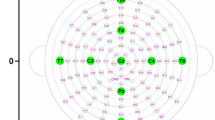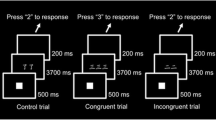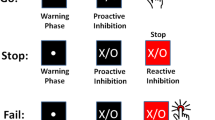Abstract
Deficits in executive functions, e.g. voluntary selection, are considered central to the attention-deficit/hyperactivity disorder (ADHD). The aim of this simultaneous EEG/fMRI study was to examine associated neural correlates in ADHD patients. Patients with ADHD and healthy subjects performed an adapted go/nogo task including a voluntary selection condition allowing participants to freely decide, whether to press the response button. Electrophysiologically, response inhibition and voluntary selection led to fronto-central responses. The fMRI data revealed increased medial/lateral frontal and parietal activity during the voluntary selection task. Frontal brain responses were reduced in ADHD patients compared to controls during free responses, whereas parietal brain functions seemed to be unaffected. These results may indicate that selection processes are related to dysfunctions, predominantly in frontal brain regions in ADHD patients.



Similar content being viewed by others
References
Aron AR, Poldrack RA (2005) The cognitive neuroscience of response inhibition: relevance for genetic research in attention-deficit/hyperactivity disorder. Biol Psychiatry 57:1285–1292
Arrington CM, Logan GD (2004) The cost of a voluntary task switch. Psychol Sci 15:610–615
Barkley RA (1997) Behavioral inhibition, sustained attention, and executive functions: constructing a unifying theory of ADHD. Psychol Bull 121:65–94
Bartholow BD, Pearson MA, Dickter CL, Sher KJ, Fabiani M, Gratton G (2005) Strategic control and medial frontal negativity: beyond errors and response conflict. Psychophysiology 42:33–42
Bekker EM, Kenemans JL, Verbaten MN (2004) Electrophysiological correlates of attention, inhibition, sensitivity and bias in a continuous performance task. Clin Neurophysiol 115:2001–2013
Bekker EM, Overtoom CC, Kooij JJ, Buitelaar JK, Verbaten MN, Kenemans JL (2005) Disentangling deficits in adults with attention-deficit/hyperactivity disorder. Arch Gen Psychiatry 62:1129–1136
Botvinick MM, Braver TS, Barch DM, Carter CS, Cohen JD (2001) Conflict monitoring and cognitive control. Psychol Rev 108:624–652
Brass M, Derrfuss J, Forstmann B, von Cramon DY (2005) The role of the inferior frontal junction area in cognitive control. Trends Cogn Sci 9:314–316
Braver TS, Barch DM, Kelley WM, Buckner RL, Cohen NJ, Miezin FM et al (2001) Direct comparison of prefrontal cortex regions engaged by working and long-term memory tasks. Neuroimage 14:48–59
Bruin KJ, Wijers AA, van Staveren AS (2001) Response priming in a go/nogo task: do we have to explain the go/nogo N2 effect in terms of response activation instead of inhibition? Clin Neurophysiol 112:1660–1671
Bush G, Frazier JA, Rauch SL, Seidman LJ, Whalen PJ, Jenike MA et al (1999) Anterior cingulate cortex dysfunction in attention-deficit/hyperactivity disorder revealed by fMRI and the Counting Stroop. Biol Psychiatry 45:1542–1552
Bush G, Valera EM, Seidman LJ (2005) Functional neuroimaging of attention-deficit/hyperactivity disorder: a review and suggested future directions. Biol Psychiatry 57:1273–1284
Cabeza R, Nyberg L (2000) Imaging cognition II: an empirical review of 275 PET and fMRI studies. J Cogn Neurosci 12:1–47
Casey BJ, Castellanos FX, Giedd JN, Marsh WL, Hamburger SD, Schubert AB et al (1997) Implication of right frontostriatal circuitry in response inhibition and attention-deficit/hyperactivity disorder. J Am Acad Child Adolesc Psychiatry 36:374–383
Casey BJ, Thomas KM, Welsh TF, Badgaiyan RD, Eccard CH, Jennings JR et al (2000) Dissociation of response conflict, attentional selection, and expectancy with functional magnetic resonance imaging. Proc Natl Acad Sci USA 97:8728–8733
Connors CK, Erhardt D, Sparrow E (1999) Conners’ Adult ADHD Rating Scales (CAARS). Multi-Health Systems, North Tonawanda, New York
Debener S, Ullsperger M, Siegel M, Engel AK (2006) Single-trial EEG-fMRI reveals the dynamics of cognitive function. Trends Cogn Sci 10:558–563
Debener S, Ullsperger M, Siegel M, Fiehler K, von Cramon DY, Engel AK (2005) Trial-by-trial coupling of concurrent electroencephalogram and functional magnetic resonance imaging identifies the dynamics of performance monitoring. J Neurosci 25:11730–11737
Deiber MP, Passingham RE, Colebatch JG, Friston KJ, Nixon PD, Frackowiak RS (1991) Cortical areas and the selection of movement: a study with positron emission tomography. Exp Brain Res 84:393–402
Dickstein SG, Bannon K, Castellanos FX, Milham MP (2006) The neural correlates of attention deficit hyperactivity disorder: an ALE meta-analysis. J Child Psychol Psychiatry 47:1051–1062
Donchin E, Coles MGH (1988) Is the P300 component a manifestation of context updating? Behav Brain Sci 11:355–372
Donkers FC, van Boxtel GJ (2004) The N2 in go/no-go tasks reflects conflict monitoring not response inhibition. Brain Cogn 56:165–176
Durston S, Thomas KM, Worden MS, Yang Y, Casey BJ (2002) The effect of preceding context on inhibition: an event-related fMRI study. Neuroimage 16:449–453
Eichele T, Specht K, Moosmann M, Jongsma ML, Quiroga RQ, Nordby H et al (2005) Assessing the spatiotemporal evolution of neuronal activation with single-trial event-related potentials and functional MRI. Proc Natl Acad Sci USA 102:17798–17803
Falkenstein M, Hoormann J, Hohnsbein J (1999) ERP components in Go/Nogo tasks and their relation to inhibition. Acta Psychol (Amst) 101:267–291
Fallgatter AJ, Ehlis AC, Seifert J, Strik WK, Scheuerpflug P, Zillessen KE et al (2004) Altered response control and anterior cingulate function in attention-deficit/hyperactivity disorder boys. Clin Neurophysiol 115:973–981
Fassbender C, Schweitzer JB (2006) Is there evidence for neural compensation in attention deficit hyperactivity disorder? A review of the functional neuroimaging literature. Clin Psychol Rev 26:445–465
Forstmann BU, Brass M, Koch I, von Cramon DY (2006) Voluntary selection of task sets revealed by functional magnetic resonance imaging. J Cogn Neurosci 18:388–398
Forstmann BU, Ridderinkhof KR, Kaiser J, Bledowski C (2007) At your own peril: an ERP study of voluntary task set selection processes in the medial frontal cortex. Cogn Affect Behav Neurosci 7:286–296
Frith CD, Friston K, Liddle PF, Frackowiak RS (1991) Willed action and the prefrontal cortex in man: a study with PET. Proc Biol Sci 244:241–246
Gajewski PD, Stoerig P, Falkenstein M (2008) ERP-correlates of response selection in a response conflict paradigm. Brain Res 1189:127–134
Garavan H, Ross TJ, Murphy K, Roche RA, Stein EA (2002) Dissociable executive functions in the dynamic control of behavior: inhibition, error detection, and correction. Neuroimage 17:1820–1829
Garon N, Moore C, Waschbusch DA (2006) Decision making in children with ADHD only, ADHD-anxious/depressed, and control children using a child version of the Iowa Gambling Task. J Atten Disord 9:607–619
Geurts HM, Verte S, Oosterlaan J, Roeyers H, Sergeant JA (2004) How specific are executive functioning deficits in attention deficit hyperactivity disorder and autism? J Child Psychol Psychiatry 45:836–854
Goldberg II, Harel M, Malach R (2006) When the brain loses its self: prefrontal inactivation during sensorimotor processing. Neuron 50:329–339
Harvey PO, Fossati P, Pochon JB, Levy R, Lebastard G, Lehericy S et al (2005) Cognitive control and brain resources in major depression: an fMRI study using the n-back task. Neuroimage 26:860–869
Hyder F, Phelps EA, Wiggins CJ, Labar KS, Blamire AM, Shulman RG (1997) “Willed action”: a functional MRI study of the human prefrontal cortex during a sensorimotor task. Proc Natl Acad Sci USA 94:6989–6994
Iaboni F, Douglas VI, Baker AG (1995) Effects of reward and response costs on inhibition in ADHD children. J Abnorm Psychol 104:232–240
Ille N, Berg P, Scherg M (2002) Artifact correction of the ongoing EEG using spatial filters based on artifact and brain signal topographies. J Clin Neurophysiol 19:113–124
Jahanshahi M, Jenkins IH, Brown RG, Marsden CD, Passingham RE, Brooks DJ (1995) Self-initiated versus externally triggered movements. I. An investigation using measurement of regional cerebral blood flow with PET and movement-related potentials in normal and Parkinson’s disease subjects. Brain 118(Pt 4):913–933
Jueptner M, Stephan KM, Frith CD, Brooks DJ, Frackowiak RS, Passingham RE (1997) Anatomy of motor learning. I. Frontal cortex and attention to action. J Neurophysiol 77:1313–1324
Kamarajan C, Porjesz B, Jones KA, Choi K, Chorlian DB, Padmanabhapillai A et al (2005) Alcoholism is a disinhibitory disorder: neurophysiological evidence from a Go/No-Go task. Biol Psychol 69:353–373
Karch S, Jager L, Karamatskos E, Graz C, Stammel A, Flatz W et al (2008) Influence of trait anxiety on inhibitory control in alcohol-dependent patients: simultaneous acquisition of ERPs and BOLD responses. J Psychiatr Res 42:734–745
Karch S, Mulert C, Thalmeier T, Lutz J, Leicht G, Meindl T et al (2009) The free choice whether or not to respond after stimulus presentation. Hum Brain Mapp 30:2971–2985
Kessler RC, Adler L, Ames M, Barkley RA, Birnbaum H, Greenberg P et al (2005) The prevalence and effects of adult attention deficit/hyperactivity disorder on work performance in a nationally representative sample of workers. J Occup Environ Med 47:565–572
Kessler RC, Adler LA, Barkley R, Biederman J, Conners CK, Faraone SV et al (2005) Patterns and predictors of attention-deficit/hyperactivity disorder persistence into adulthood: results from the national comorbidity survey replication. Biol Psychiatry 57:1442–1451
Kim MS, Kim YY, Yoo SY, Kwon JS (2007) Electrophysiological correlates of behavioral response inhibition in patients with obsessive-compulsive disorder. Depress Anxiety 24:22–31
Konrad K, Gauggel S, Manz A, Scholl M (2000) Lack of inhibition: a motivational deficit in children with attention deficit/hyperactivity disorder and children with traumatic brain injury. Child Neuropsychol 6:286–296
Kramer AF, Strayer DL (1988) Assessing the development of automatic processing: an application of dual-task and event-related brain potential methodologies. Biol Psychol 26:231–267
Krause KH, Krause J, Trott GE (1998) Hyperkinetic syndrome (attention deficit-hyperactivity disorder) in adulthood. Nervenarzt 69:543–556
Lau H, Rogers RD, Passingham RE (2006) Dissociating response selection and conflict in the medial frontal surface. Neuroimage 29:446–451
Lau HC, Rogers RD, Ramnani N, Passingham RE (2004) Willed action and attention to the selection of action. Neuroimage 21:1407–1415
Matsuda T, Matsuura M, Ohkubo T, Ohkubo H, Atsumi Y, Tamaki M et al (2002) Influence of arousal level for functional magnetic resonance imaging (fMRI) study: simultaneous recording of fMRI and electroencephalogram. Psychiatry Clin Neurosci 56:289–290
Menon V, Crottaz-Herbette S (2005) Combined EEG and fMRI studies of human brain function. Int Rev Neurobiol 66:291–321
Mulert C, Jager L, Schmitt R, Bussfeld P, Pogarell O, Moller HJ et al (2004) Integration of fMRI and simultaneous EEG: towards a comprehensive understanding of localization and time-course of brain activity in target detection. Neuroimage 22:83–94
Mulert C, Seifert C, Leicht G, Kirsch V, Ertl M, Karch S et al (2008) Single-trial coupling of EEG and fMRI reveals the involvement of early anterior cingulate cortex activation in effortful decision making. Neuroimage 42:158–168
Nachev P, Rees G, Parton A, Kennard C, Husain M (2005) Volition and conflict in human medial frontal cortex. Curr Biol 15:122–128
Nieuwenhuis S, Yeung N, van den Wildenberg W, Ridderinkhof KR (2003) Electrophysiological correlates of anterior cingulate function in a go/no-go task: effects of response conflict and trial type frequency. Cogn Affect Behav Neurosci 3:17–26
Nigg JT (2001) Is ADHD a disinhibitory disorder? Psychol Bull 127:571–598
Oosterlaan J, Sergeant JA (1998) Response inhibition and response re-engagement in attention-deficit/hyperactivity disorder, disruptive, anxious and normal children. Behav Brain Res 94:33–43
Passingham RE (1995) The frontal lobes and voluntary action. Oxford University Press, Oxford
Playford ED, Jenkins IH, Passingham RE, Nutt J, Frackowiak RS, Brooks DJ (1992) Impaired mesial frontal and putamen activation in Parkinson’s disease: a positron emission tomography study. Ann Neurol 32:151–161
Polich J, Kok A (1995) Cognitive and biological determinants of P300: an integrative review. Biol Psychol 41:103–146
Retz-Junginger P, Retz W, Blocher D, Weijers HG, Trott GE, Wender PH et al (2002) Wender Utah rating scale. The short-version for the assessment of the attention-deficit hyperactivity disorder in adults. Nervenarzt 73:830–838
Ridderinkhof KR, Ullsperger M, Crone EA, Nieuwenhuis S (2004) The role of the medial frontal cortex in cognitive control. Science 306:443–447
Ritter W, Simson R, Vaughan HG Jr (1983) Event-related potential correlates of two stages of information processing in physical and semantic discrimination tasks. Psychophysiology 20:168–179
Ritter W, Simson R, Vaughan HG Jr, Macht M (1982) Manipulation of event-related potential manifestations of information processing stages. Science 218:909–911
Rubia K, Smith AB, Brammer MJ, Taylor E (2003) Right inferior prefrontal cortex mediates response inhibition while mesial prefrontal cortex is responsible for error detection. Neuroimage 20:351–358
Rushworth MF, Buckley MJ, Behrens TE, Walton ME, Bannerman DM (2007) Functional organization of the medial frontal cortex. Curr Opin Neurobiol 17:220–227
Schachar R, Mota VL, Logan GD, Tannock R, Klim P (2000) Confirmation of an inhibitory control deficit in attention-deficit/hyperactivity disorder. J Abnorm Child Psychol 28:227–235
Schulz KP, Fan J, Tang CY, Newcorn JH, Buchsbaum MS, Cheung AM et al (2004) Response inhibition in adolescents diagnosed with attention deficit hyperactivity disorder during childhood: an event-related FMRI study. Am J Psychiatry 161:1650–1657
Sergeant JA, Geurts H, Huijbregts S, Scheres A, Oosterlaan J (2003) The top and the bottom of ADHD: a neuropsychological perspective. Neurosci Biobehav Rev 27:583–592
Sergeant JA, Geurts H, Oosterlaan J (2002) How specific is a deficit of executive functioning for attention-deficit/hyperactivity disorder? Behav Brain Res 130:3–28
Siniatchkin M, Boor R, Jacobs J, Wolff S, Jansen O, Stephani U et al (2006) Correction of ballistocardiogram artefacts from EEG acquired in the MRI scanner using spatial filters based on artefact and brain signal topographies. Neuroimage 31:S86
Sirigu A, Daprati E, Ciancia S, Giraux P, Nighoghossian N, Posada A et al (2004) Altered awareness of voluntary action after damage to the parietal cortex. Nat Neurosci 7:80–84
Smith JL, Johnstone SJ, Barry RJ (2004) Inhibitory processing during the Go/NoGo task: an ERP analysis of children with attention-deficit/hyperactivity disorder. Clin Neurophysiol 115:1320–1331
Sonuga-Barke EJ, Dalen L, Daley D, Remington B (2002) Are planning, working memory, and inhibition associated with individual differences in preschool ADHD symptoms? Dev Neuropsychol 21:255–272
Tamm L, Menon V, Ringel J, Reiss AL (2004) Event-related FMRI evidence of frontotemporal involvement in aberrant response inhibition and task switching in attention-deficit/hyperactivity disorder. J Am Acad Child Adolesc Psychiatry 43:1430–1440
Turken AU, Swick D (1999) Response selection in the human anterior cingulate cortex. Nat Neurosci 2:920–924
Vaidya CJ, Austin G, Kirkorian G, Ridlehuber HW, Desmond JE, Glover GH et al (1998) Selective effects of methylphenidate in attention deficit hyperactivity disorder: a functional magnetic resonance study. Proc Natl Acad Sci USA 95:14494–14499
Walton ME, Devlin JT, Rushworth MF (2004) Interactions between decision making and performance monitoring within prefrontal cortex. Nat Neurosci 7:1259–1265
Watanabe J, Sugiura M, Sato K, Sato Y, Maeda Y, Matsue Y et al (2002) The human prefrontal and parietal association cortices are involved in NO-GO performances: an event-related fMRI study. Neuroimage 17:1207–1216
Williams D, Stott CM, Goodyer IM, Sahakian BJ (2000) Specific language impairment with or without hyperactivity: neuropsychological evidence for frontostriatal dysfunction. Dev Med Child Neurol 42:368–375
Zametkin AJ, Nordahl TE, Gross M, King AC, Semple WE, Rumsey J et al (1990) Cerebral glucose metabolism in adults with hyperactivity of childhood onset. N Engl J Med 323:1361–1366
Zang YF, Jin Z, Weng XC, Zhang L, Zeng YW, Yang L et al (2005) Functional MRI in attention-deficit hyperactivity disorder: evidence for hypofrontality. Brain Dev 27:544–550
Acknowledgments
This study is part of the MD thesis of Tobias Thalmeier at the Faculty of Medicine, Ludwig-Maximilians-University, Munich. We thank Mije Hartmann who assisted with the proof-reading of the manuscript. All authors reported no biomedical financial interest or potential conflict of interest. This study was supported by the Faculty of Medicine, University of Munich (Förderprogramm für Forschung und Lehre; FöFoLe-572).
Author information
Authors and Affiliations
Corresponding author
Rights and permissions
About this article
Cite this article
Karch, S., Thalmeier, T., Lutz, J. et al. Neural correlates (ERP/fMRI) of voluntary selection in adult ADHD patients. Eur Arch Psychiatry Clin Neurosci 260, 427–440 (2010). https://doi.org/10.1007/s00406-009-0089-y
Received:
Accepted:
Published:
Issue Date:
DOI: https://doi.org/10.1007/s00406-009-0089-y




